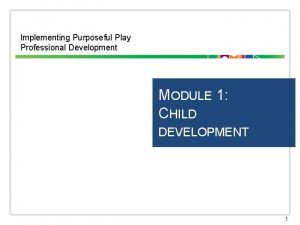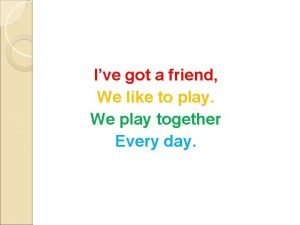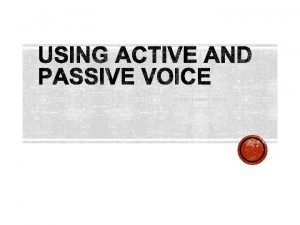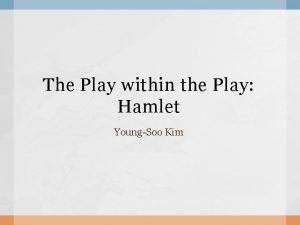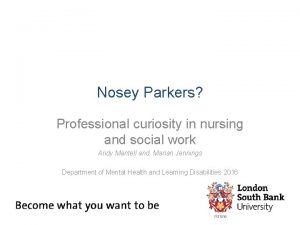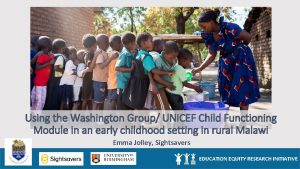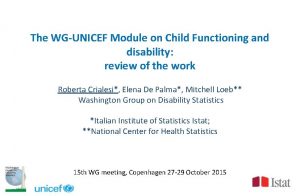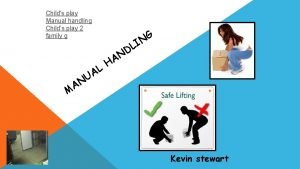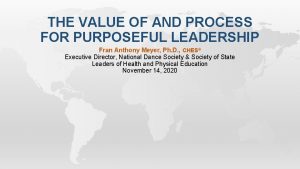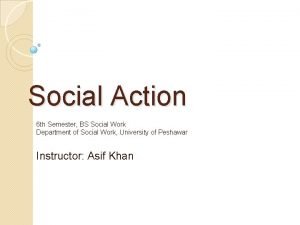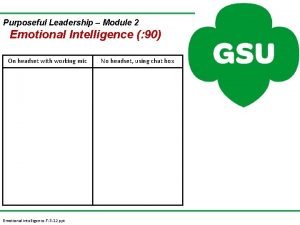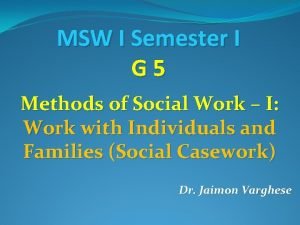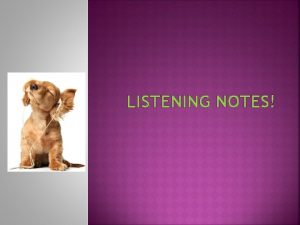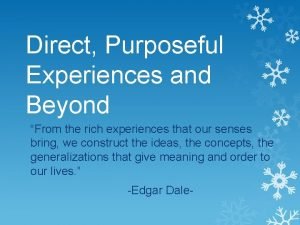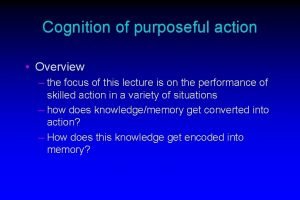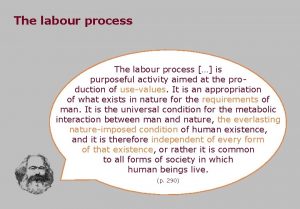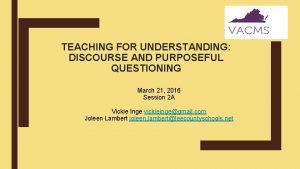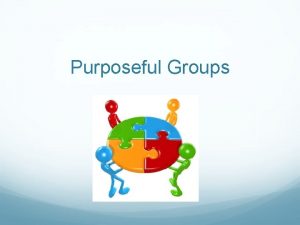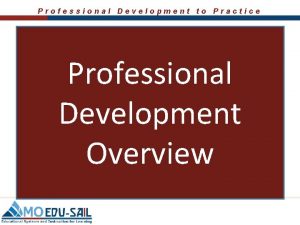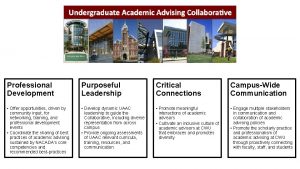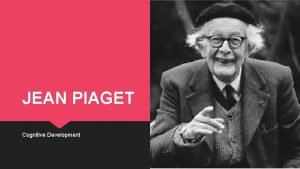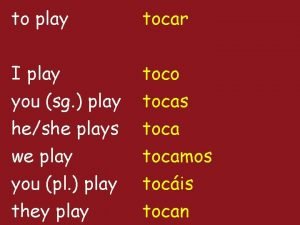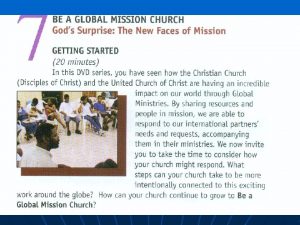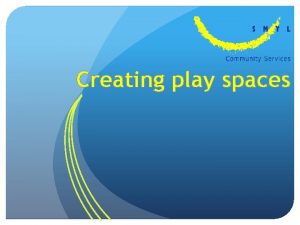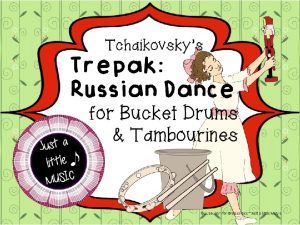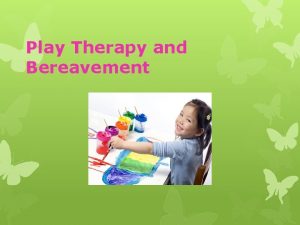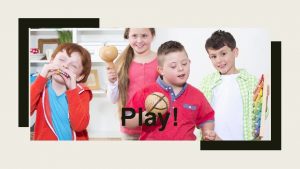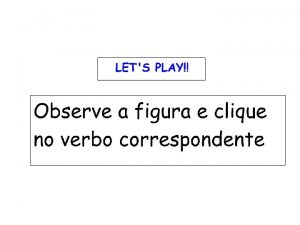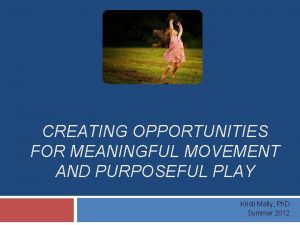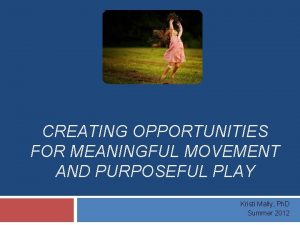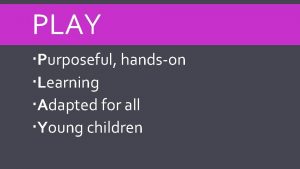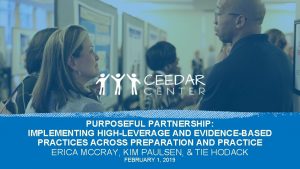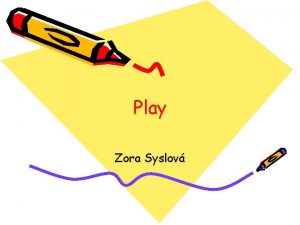Implementing Purposeful Play Professional Development MODULE 1 CHILD
























- Slides: 24

Implementing Purposeful Play Professional Development MODULE 1: CHILD DEVELOPMENT 1

WELCOME • Introductions • Overview • Group Norms • Learning Outcomes 2

LEARNING OUTCOMES • Understand the stages of child development in the following domains: – – Social-Emotional Physical Cognitive Language • Learn about current brain research • Consider the implications of child development on your teaching practices • Investigate strategies to differentiate learning 3

AGENDA • • What is Child Development? Key Understandings What does Brain Research tell us? Domains of Learning & Development for Children Ages 3 – 6 Implications for Teaching What does Child Development have to do with Kindergarten? A Focus on Differentiation: Information & Strategies 4

THINK, CHAT, WRITE • Activity: – With your shoulder partner, share your thoughts about the following question to create and write out your own definition of child development on the “Child Development” recording sheet: What IS child development? 5

CHILD DEVELOPMENT & KINDERGARTEN • “Effective teaching practice in kindergarten is based on our knowledge of child growth and development and increasingly also on discoveries about brain development that have emerged in recent years”. NC Guide for the Early Years, 2009, 13 6

BRAIN RESEARCH Early experiences actually shape the architecture of the brain and strongly affect whether a child grows up to be a healthy, productive member of society. 7

BRAIN RESEARCH • • • Research on brain development • University of Washington I-LABS: Institute for Learning & Brain Sciences Research on effects of poverty • Study from University of Wisconsin and University of NC School of Medicine • Study from Washington University School of Medicine Research on effects of stress • Study from Harvard University-Center on the Developing Child https: //www. youtube. com/watch? v=r. Vw. Fkc. OZHJw 8

BRAIN RESEARCH • New brain cells grow every day (Neurogenesis) • – Brains CAN change and Teacher CAN influence the brain Ways to help brain development: – Learning and changing your students’ brains requires continual engagement. If they’re not engaged, time is wasted. (Jensen, 4 -4 -14) – Direct instruction time guideline for K-2 is 5 -7 minutes (Jensen, 1998) – “The brain needs 8 to 12 glasses of water a day for optimal functioning. Dehydration is a common problem in school classrooms, leading to lethargy and impaired learning” (Jenson, 1998) – Physical activity can increase the production of new brain cells, a process highly correlated with learning, mood, and memory (Pereira et al. , 2007) – The arts can improve attention, sequencing, processing and cognitive skills (Gazzaniga, Asbury & Rick, 2008) – Music enhances self-discipline, wide brain function, and verbal memory (Chan, Ho, & Cheung, 1998) 9

KEY UNDERSTANDINGS 1. Every child is different. 2. Learning occurs in predictable patterns. 3. Learning is most meaningful when integrated across all domains. 4. Young children are active learners. 5. Experience, knowledge, curiosity, and a sense of wonder are foundations for learning. 6. Assessment and evaluation form the basis for educational decisions. 7. Development and learning are rooted in culture and supported by family. NC Guide for the Early Years, 2009 10

KEY UNDERSTANDINGS • Every child is different. 11

KEY UNDERSTANDINGS • Learning occurs in predictable patterns – Although each child is unique, development typically happens in progressive stages. – What varies greatly from child to child • When and how children achieve developmental milestones • Differences depend on many factors such as: – Temperament, gender, race, family culture – Highly Capable or children with delays may exhibit greater variations – Poverty/Stress 12

DOMAINS OF LEARNING & DEVELOPMENT Learning • Physical Standards development –Gross motor –Fine motor Learning • Cognitive Standards Development –Mathematics –Science –Social Studies Learning • Social Emotional Learning Standards Development • Language –Sense of Self –Literacy –Communication –Sense of Self with Others 13

ACTIVITY CHILD DEVELOPMENT SEQUENCING • Small Group Work – Create 4 small groups • • Cognitive Development Physical Development Social Emotional Development Language Development – Put cards in order of patterns of development for your assigned domain by age level (3, 4, or 5) – Share out developmental sequences • What were your groups AHAs? • What surprised you about the sequences within your domain area? 14

BREAK • 10 minutes 15

DEVELOPMENTAL STAGES • Video clips on age levels (3, 4, 5) • As you watch the clip, jot down –AHAs, –Questions, and –Significances for Differentiation on the “Developmental Stages Recording Sheet” • Consider: When a child’s development and learning does not seem to fit what is included in the Standards continuum under his/her age level, look at the Indicators for younger or older age groups to see if they are a better fit for the child. The goal is to learn what developmental steps the child is taking now, and to meet the individual needs of that child on a daily basis 16

THREE YEAR OLDS https: //www. youtube. com/watch? v=w 5 DWCw. Uc. Oxc 17

FOUR YEAR OLDS https: //www. youtube. com/watch? v=o 0 TGczdbi. V 4 18

FIVE YEAR OLDS https: //www. youtube. com/watch? v=7 k. AJv. GARsn 0 19

THE SHIFT: THE DEVELOPMENT AND LEARNING OF KINDERGARTEN AGE CHILDREN https: //www. youtube. com/watch? v=i. Mo_VP 7 N_Tk 20

INDICATORS AND IMPLICATIONS • Handout “Child Indicators” • This is a resource to use to determine red flags you may see with your students. 21

KEY UNDERSTANDINGS 1. Every child is different 2. Learning occurs in predictable patterns 3. Learning is most meaningful when integrated across all domains 4. Young children are active learners 5. Experience, knowledge, curiosity, and a sense of wonder are foundations for learning 6. Assessment and evaluation form the basis for educational decisions 7. Development and learning are rooted in culture and supported by family NC Guide for the Early Years, 2009 22

REVISITING LEARNING OUTCOMES • Understand the stages of child development in the following domains: – – Social-Emotional Physical Cognitive Language • Learn about current brain research • Consider the implications of child development on your teaching practices • Investigate strategies to differentiate learning 23

CLOSING REFLECTION • Revisit definition of child development • Ponder these questions: – Based on the experiences today, why is this important information for kindergarten teachers to know? – What are you doing well already? – What will you do differently now? • Record your thoughts on the “Child Development Reflection” handout • Discuss with a partner 24
 Purposeful play definition
Purposeful play definition C device module module 1
C device module module 1 I've got a friend we like to play we play together
I've got a friend we like to play we play together Play random play basketball
Play random play basketball Typewriter types
Typewriter types Play within the play hamlet
Play within the play hamlet Professional curiosity
Professional curiosity What is child functioning module
What is child functioning module Child functioning module
Child functioning module Child's play manual handling
Child's play manual handling 패자트리
패자트리 Purposeful leadership
Purposeful leadership Rational purposeful action
Rational purposeful action The seven principles of social work
The seven principles of social work Purposeful leadership
Purposeful leadership Purposeful expression of feelings in social work
Purposeful expression of feelings in social work Nurse leader rounding
Nurse leader rounding Discriminative listening
Discriminative listening Don tiburcio de espadaña
Don tiburcio de espadaña Purposeful action examples
Purposeful action examples Labour is the purposeful process of
Labour is the purposeful process of Purposeful questioning
Purposeful questioning Listening activity
Listening activity Planning business messages chapter 2
Planning business messages chapter 2 Purposeful listening
Purposeful listening
